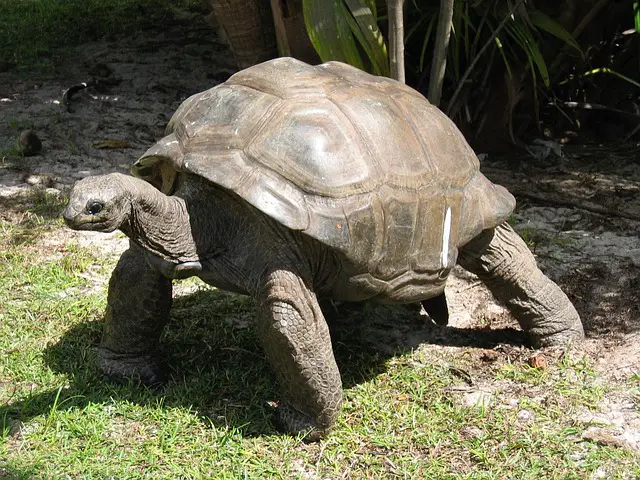The frequency of changing tortoise bedding depends on several factors. One of the most important factors is the type of bedding used.
Some bedding materials, such as newspaper and paper towels, are easy to clean and can be changed daily. Others, such as soil and sand, require less frequent changes.
Another factor is the size of the enclosure and the number of tortoises living in it. The more tortoises there are in the enclosure, the more often the bedding will need to be changed.
Additionally, the age and health of the tortoise can also affect how often the bedding needs to be changed.
Younger tortoises tend to be messier, so their bedding may need to be changed more frequently. To maintain a clean and hygienic environment, sick or injured tortoises may need more frequent bedding changes.
Understanding these factors can help tortoise owners determine how often they should change their pet’s bedding.
How Often to Change Bedding
General Guideline
When it comes to tortoise bedding, it is essential to keep it clean and fresh to ensure the health and well-being of your pet.
The frequency at which you should change the bedding depends on various factors, such as the enclosure size, the number of tortoises, and the type of bedding used.
As a general guideline, changing the bedding at least once a week is recommended.
Specific Tortoise Species
Different tortoise species have different needs and requirements when it comes to bedding. Here are some specific recommendations for some common tortoise species:
- Russian tortoise: Russian tortoises require a dry environment, so it is recommended to use a substrate such as a coconut coir or orchid bark. The bedding should be spot-cleaned daily and completely changed every two to three weeks.
- Sulcata tortoise: Sulcata tortoises require a substrate that can hold moisture, such as coconut coir or cypress mulch. The bedding should be spot-cleaned daily and completely changed every two weeks.
- Red-footed tortoise: Red-footed tortoises prefer a substrate that can hold moisture, such as coconut coir or sphagnum moss. The bedding should be spot-cleaned daily and completely changed every two weeks.
It is important to note that these are just general recommendations, and the frequency at which you should change the bedding may vary based on individual circumstances. It is always essential to monitor the cleanliness of the enclosure and the health of your tortoise to ensure they live in a safe and healthy environment.
Factors that Affect the Frequency of Bedding Change
Tortoise Species
Different species of tortoises have varying needs when it comes to bedding. Some species require more frequent changes than others.
For example, desert tortoises that live in a dry environment may only need their bedding changed every few months.
Meanwhile, tropical tortoises that live in a humid environment may require bedding changes as often as once a week.
It’s essential to research the specific needs of your tortoise species to determine how often to change their bedding.
Size of Enclosure
The size of the enclosure also affects how often bedding needs to be changed. The larger the enclosure, the less frequently the bedding must be changed.
This is because the tortoise has more space to move around, and the waste is more spread. In a small enclosure, waste can accumulate quickly and cause health problems for the tortoise.
It’s essential to provide a large enough enclosure for your tortoise to prevent this issue.
Number of Tortoises
The number of tortoises in an enclosure also affects the frequency of bedding changes. More tortoises mean more waste, which means more frequent bedding changes.
If you have multiple tortoises in an enclosure, monitoring the bedding and changing it to maintain a healthy environment is essential.
Type of Bedding
The type of bedding used can also affect how often it needs to be changed. Some types of bedding, such as newspaper or paper towels, can be changed daily or every other day.
Other types of bedding, such as coconut coir or cypress mulch, may only need to be changed once a month. It’s essential to research the specific needs of your tortoise species and the type of bedding you’re using to determine how often to change it.
Overall, several factors affect how often tortoise bedding needs to be changed.
Researching your tortoise species and providing a large enough enclosure with appropriate bedding to maintain a healthy environment is essential.
Signs that Indicate Bedding Change
Odor
A strong odor is one of the most noticeable signs that tortoise bedding needs to be changed. When the bedding starts to smell bad, it’s an indication that it’s time to replace it.
The odor can be caused by the accumulation of urine and feces, creating an unpleasant smell that can harm the tortoise’s health.
Mold Growth
Another sign that it’s time to change the bedding is mold growth. Mold can grow on the bedding when damp, which can happen if the tortoise spills water or urinates.
Mold can be harmful to the tortoise’s health, and it can cause respiratory problems.
Wetness or Dampness
Wetness or dampness is another sign that the tortoise bedding needs to be changed. If the bedding is wet, it can cause the tortoise to become sick or develop respiratory problems.
Keeping the bedding dry and clean is essential to prevent mold and bacteria growth.
In summary, the signs that indicate tortoise bedding needs to be changed include odor, mold growth, and wetness or dampness.
It’s essential to keep the bedding clean and dry to prevent the growth of harmful bacteria and mold, which can cause health problems for the tortoise.




